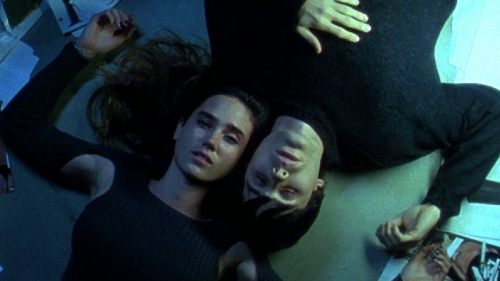Totally Fucked Up: CLIMAX
The canon of cinema boasts a wealth of films that have earned the prestigious designation of “classic” and years of exhaustive praise and analysis. But beneath this esteemed catalog exists an “alt-canon” that features some of the most disturbing, provocative, unsettling, deranged, and devastating works in cinematic history. Although often just as masterful as the mainstream and arthouse classics, critics and audiences have found these movies a little harder to love. Totally Fucked Up is a weekly column that examines the films in this alt-canon and the auteurs who made them.
If you engage with every piece of media like it’s a puzzle to be solved, Gaspar Noe makes it easy for you in the opening scene (technically; experientially, it’s the second) of CLIMAX. Set in 1996 and loosely inspired by an actual event, Noe’s dizzying, aggressively avant-garde production begins with a taped interview, in which choreographer Selva and her collaborator, DJ Daddy, speak with various dancers about forming a troupe. The television is surrounded with stacks of VHS tapes and books, a collection of obvious clues for the intrepid movie-solver: Titles like POSSESSION, SALO, UN CHIEN ANDALOU, SUSPIRIA, LABYRINTH MAN (the French title for ERASERHEAD), and ZOMBIE alongside the writings of Nietzsche, Freud, Baudelaire, Wilde, and Kafka. It’s a literal framing device, the combination of titles and names surrounding it a key to the madness that follows.

During the interviews, Selva and Daddy ask the dancers about their craft, their personal lives and relationships, and their greatest fears. The unspoken answer to that question is, of course, “losing control.” This is the thread that joins these artists together; CLIMAX is Noe’s observation of what happens when that thread is pulled and they come undone. Noe built his ensemble from dancers with no prior acting experience—save for Souheila Yacoub (Lou) and Sofia Boutella (Selva)—and pulled many of them from the realms of ballroom (vogue, in particular) and krump. Although these styles are largely improvisational and dance as an art form is expressionistic, the medium requires a substantial degree of self-control. After living together and collaborating on their performance for a couple of weeks in an abandoned school, the dancers throw a party where most of them unwittingly consume LSD from a batch of spiked sangria. What begins as a subtle perception of the uncanny rapidly devolves into a psychedelic nightmare. As the night veers wildly on, the dancers grow increasingly unhinged and primitive—a direct correlation to their diminishing sense of control.
And then: Shit most assuredly pops off. It is the antithesis of PURE MOODS VOL. 2.
In what feels like Gaspar Noe’s rendering of the notoriously debaucherous Olympic Village, each dancer embarks on a personal odyssey through hell, occasionally overlapping with another to form an unwieldy tapestry of mania. A woman’s hair catches on fire in the kitchen while another laughs; troupe manager Emmanuelle locks her son in an electrical closet after he drinks some of the sangria, and he electrocutes himself; dancers whiplash their way through the spectrum of violent emotions, throwing themselves on the floor, contorting their bodies, clawing at their skin and pulling at hair—an intensely sensual depiction of a kaleidoscope of senseless behavior.
Because this is 2020 and we're seeing everything through the shit-smeared prism of the pandemic, CLIMAX also feels like a metaphor for the convoluted psychological hell of quarantine. So it's that, too.
But also: The dancing. CLIMAX officially kicks off with an extended dance sequence, a ritual to commence the bacchanal that follows. The dancers perform both independently and as part of a cohesive unit, delivering a kinesthetic prophecy of the subsequent narrative. Those early VHS breadcrumbs are littered throughout, from the ferocious feminine mania of POSSESSION to the LSD’s domino effect, which effectively “infects” each dancer and turns them into mindless, ravenous bodies not unlike the hordes of undead in ZOMBIE. The odyssey culminates in an orgiastic, dizzying spectacle in which dancers succumb to their baser instincts and their bodies writhe and convulse as if demonically possessed.
A title notably absent from the opening tableau is THE TEXAS CHAIN SAW MASSACRE, to which Noe owes the climax of Lou’s arc. One of the only dancers to abstain from the sangria, Lou confesses to Selva that she’s pregnant. Their intimate discussion is interrupted by Dom (Mounia Assangar), who accuses Lou of spiking the punch and knocks her to the ground, where she violently kicks at Lou’s stomach. The others follow Lou’s lead and set upon Lou like a right-wing mob—ill-informed and excruciatingly belligerent—and begin goading her, demanding she kill herself. Lou punches herself in the stomach and uses a knife to cut her arm and face; an artist conceding to the demands of a bloodthirsty crowd.

When Lou finally escapes, she stumbles out of the abandoned school into the stark brightness of a snowy day. She falls to the ground and begins clawing her way across the infinite white landscape, sobbing uncontrollably and laughing—the portrait of a hysterical woman finally liberated from some unspeakable trauma, not unlike Sally Hardesty in the final frame of Tobe Hooper’s horror classic.
As with IRREVERSIBLE (another selection from the alt-canon), Noe’s editing aggressively upends conventional cinematic structure. The opening is a sly, self-aware provocation that toys with the viewer’s expectations: Lou screaming and laughing, bloody in the snow before the end credits play out in reverse and we return to the “beginning,” when Selva and Daddy interview the dancers. Noe is not subverting expectations—cinematic or otherwise—but perverting them. After Lou exits (again), the camera doesn't revisit her cathartic escape, but instead follows the other dancers in the surreal morning after—the brother and sister who finally gave in to their taboo and extremely Freudian desires; Emmanuelle’s lifeless body cradled by blood on the floor outside the electrical closet; her son’s body on the opposite side of the door, painfully close, their heads almost touching in their mirrored fetal positions.
And finally, there’s Psyche (Thea Carla Schøtt)—the one dancer who didn’t have an adverse reaction to the LSD. She calmly sits on her bed, copies of LSD PSYCHOTHERAPY and Christiane F.’s memoir casually tumbling out of her purse as she pulls out a bottle and drops clear liquid—more LSD—into her eyes. The presumption up to this point being that Emmanuelle had spiked the punch in an effort to induce unhinged artistic expression, treating the dancers of her troupe like an experiment. But it was nothing so sinister as that.
Instead, CLIMAX is merely the story of a bored artist who thought it might be fun if everyone else got on her level.


_500_281_81_s_c1.jpg)
